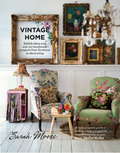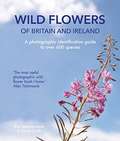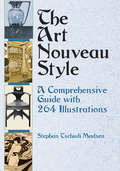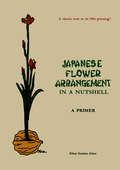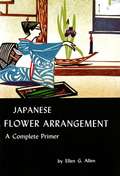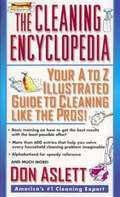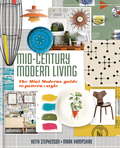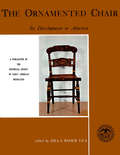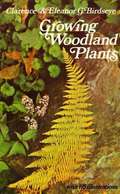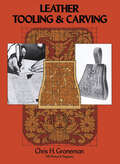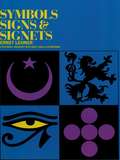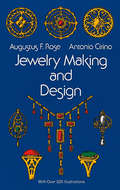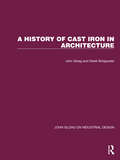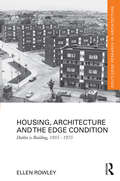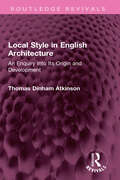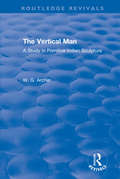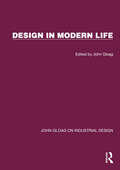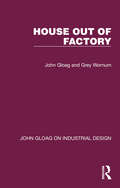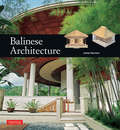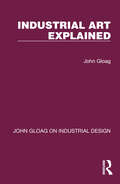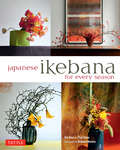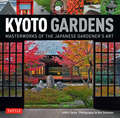- Table View
- List View
Vintage Home: Stylish Ideas And Over 50 Handmade Projects From Furniture To Decorating
by Sarah MooreRecycle, revamp and rejuvenate; with over 50 projects Sarah covers a whole spectrum of imaginative ideas for every room of the house, from blanket curtains to patchwork wallpaper, clever storage crates to fun mobiles for children, as well as unique ideas for dining, sleeping and bathing. Interweaved throughout the book are ideas for 'one thing four ways' to show how the same piece of furniture or a room can be updated with different look, plus handy advice on essential kit and techniques. Aimed at all skill levels, the projects can be completed in a few hours or over a weekend so you can revamp and refurbish your home in no time at all.
Wild Flowers of Britain and Ireland
by Rae Spencer Jones Sarah CuttleThe close-up photographs allow you to examine each plant in detail - so you will know your English from your Spanish bluebell - and because it is done by colour instead of name, it is much easier to navigate.Full of fascinating information, including where and when you will find the flowers, their characteristics, and anecdotes on their historical background with their medicinal and culinary uses. You don't even need to go out into the field to enjoy these beautiful and sometimes elusive flowers.
The Art Nouveau Style: A Comprehensive Guide with 264 Illustrations
by Stephan Tschudi MadsenA revolutionary reaction to traditional nineteenth-century art, the turn-of-the-century Art Nouveau movement drew much of its inspiration from nature. Applying its sinuous, curvilinear motifs to the decorative arts, graphics, architecture, sculpture, and painting, artists and craftspeople attempted to create a style suitable for a "modern" age. In this absorbing, exceptionally detailed, and well-researched book (one of the first scholarly works to revive interest in the style after World War II), a noted Norwegian authority on the subject examines the movement in depth. Stephan Madsen offers a wealth of facts and insights about the origins and development of the style; trends leading up to Art Nouveau, including the influence of Blake and the Pre-Raphaelites; early Art Nouveau posters and book illustrations; and its use in architectural ornamentation, furniture, jewelry, wrought-iron, glass, and other applied arts. A magnificent selection of 264 photographs and line drawings accompanies the text, which gives broad coverage to the movement, as well as insightful discussions of such important artists as Emile Gallé, Alphonse Mucha, Walter Crane, Charles Rennie Mackintosh, Aubrey Beardsley, Henry Van de Velde, Victor Horta, William Morris, and Eugène Grasset.Artists and students, admirers of Art Nouveau, and anyone interested in this enduring and influential style will welcome Professor Madsen's expert, fully documented study.
Japanese Flower Arrangement: A Primer
by Ellen Gordon AllenThis Japanese gardening book is a practical, concise guide to flower arranging or Ikebana.Illustrated with dozens of helpful photographs and diagrams, this flower arranging handbook provides full and comprehensive treatment of the various forms of Moribana and Heiki style arrangements. <P><P>Each lesson is given in detail step by step with accompanying sketches, showing clearly what should be done as the arrangement progresses towards completion. The photographs of actual completed flower arrangements sum up beautifully the principles underlying each particular style.The purpose of this text is to acquaint the reader with elementary knowledge in a special school of flower arranging-the Japanese school-selected because it is the oldest and its teachings are perhaps the simplest, yet most effective. The text is intended for amateurs, but professional arrangers might find it useful as a refresher.
Japanese Flower Arrangement: A Complete Primer
by Ellen G. AllenThere is something of the artist in each of us. Some of us find expression in painting, poetry, or sculpture, some in landscape gardening. With talent and facility, expression in these art forms is Satisfying. <P><P>And this is true also of flower arranging, an ancient art that can express a thought or mood and in a sense combine the expression of severnl other media. Yet special talent for flower arranging is not essential. The 'feeling' for it is engendered by the practice of it!' With these words Ellen Gordon Allen begins the introduction to her eminently practical primer of Japanese flower arrangement, which is here being offered in a new revised edition. As a certified teacher (Oharn school)and a very successful one, Mrs. Allen is well qualified to present her subject.The purpose of her book is fourfold: to increase the skill of all who love to arrange flowers to provide a more comprehensive understanding of the Japanese art of flower arrangement; to help students when no teacher is available; andto provide a medium of instruction among the many, often confusing, schools of Japoncse flower arrangement. It is Mrs. Allen's hope that the primer will serve as a practical handbook for beginners and that it will dispel the aura ofmystery that seems to surround the subject. To this end, she has made her instructions as elementary as possible. The few fundamental rules of Japanese flower arrangement and the various techniques are presented in a simple manner.Wherever possible, English equivalents have been substituted for Japanese terms. Each lesson sketches, photographs, and diagrams which clearly show the student what to do in working toward completion of the arrangement. Although Mrs. Allen teaches principally the methods of the Ohara school for the moribana and heika styles and the methods of the Saga school for the seika style, her book is also a compilation of information from the Sogetsu, the Ikenobo, the Sho-fu·ryu, and other famous schools in Japan. She has selected what she considers most practical for use in the American or other foreign setting. By using the slep-by-step methods outlined in the 14 well-organized lessons, the Rowerarrangementstudent will not only be able to learn rapidly but will also experience the pleasure of making genuine progress in an art that provides an endless source of enjoyment. And, as Mrs. A1len expresses it, "it is the enjoyment of making flower arrangements that I want particularly to stress. Learn the fundamentalsand you will enjoy their application, sharing your pleasure with others who will marvel at your skill in arranging flowers."
The Cleaning Encyclopedia: America’s # Cleaning Expert
by Don AslettThe ultimate guide to the art of cleaning, this reference is packed with professional secrets for getting maximum results through minimum results through minimum effort. Discover how to save time, money, and elbow grease on every cleaning problem, as well as how to prevent housework with surprising tricks of the trade. From aluminum siding to zoom lenses, this alphabetical index covers every job, big and small.
Mid-Century Modern Living: The Mini Modern's Guide to Pattern and Style
by Keith Stephenson Mark HampshireBursting with beautiful ideas for bringing a signature mid-century look into your own space, as well as practical advice on what will work where, this is an essential guide for any lover of interior design and mid-century style. In this beautifully photographed book, Mark and Keith of Mini Moderns show you how to create a timeless mid-century look in your own homeKnown for their striking use of pattern and colour, Mark and Keith's designs are inspired by everything from childhood memories to commentaries on popular culture, and through this lens they explore how different influences and designers have created key mid-century looks. They delve into the cornerstones of mid-century style, from colour and pattern to materials and curation, and share their secrets on how to bring together the things you love to create your own look. They also include inspirational case studies to demonstrate particular looks, from Beatnik Beach House to Scandi Rustic, Seaside Modern to Studio Townhouse.
The Ornamented Chair
by Zilla Rider LeaDiscriminating decorators and collectors, no less than dealers and researchers in antiques, have long felt the need of a comprehensive study of the ornamented chair and its development in America. This book is the product of an effort to satisfy that need and at the same time to bring new pleasures to lovers of beautiful furniture.The book is based on photographic and research material collected by the late Esther Stevens Brazer, who spent a lifetime in the study and revival of early American decoration.The authors are all qualified researchers, teachers, and decorators. In their text they present a general history of chair types, facts regarding ornamentation, and informative accounts of some of the leading craftsmen and decorators of the various periods. The final chapter of the book briefly relates the history of the Society and describes how its members carry forward the efforts of Esther Stevens Brazer, maintaining in their research, their teaching, and their restorations the standards of an old craft and the traditions of its finest workmen.
The Ornamented Chair
by Zilla Rider LeaDiscriminating decorators and collectors, no less than dealers and researchers in antiques, have long felt the need of a comprehensive study of the ornamented chair and its development in America. This book is the product of an effort to satisfy that need and at the same time to bring new pleasures to lovers of beautiful furniture.The book is based on photographic and research material collected by the late Esther Stevens Brazer, who spent a lifetime in the study and revival of early American decoration.The authors are all qualified researchers, teachers, and decorators. In their text they present a general history of chair types, facts regarding ornamentation, and informative accounts of some of the leading craftsmen and decorators of the various periods. The final chapter of the book briefly relates the history of the Society and describes how its members carry forward the efforts of Esther Stevens Brazer, maintaining in their research, their teaching, and their restorations the standards of an old craft and the traditions of its finest workmen.
Creative Home Decorating
by Hazel Kory Rockow Julius RockowInterest in home decoration is at a higher pitch today than ever before. Modern techniques of production have made home furnishings available to all persons and at all income levels. Home decoration is a creative activity. As such, it is guided by principles and aesthetic values common to all the creative arts. Trial and error is uneconomical of money, time and effort and, all too often, never transcends error. For this reason, the authors have emphasized principles throughout the book, as well as their practical application.
Growing Woodland Plants
by Clarence Birdseye Eleanor G. BirdseyeThe authors explain the interrelationships of trees, wildflowers, ferns, bacteria, and the soil of woodlands; suggest ways of preparing both large and small wildflower gardens; and describe when, where, and how to gather woods plants. Includes detailed information on over 200 wildflowers and ferns. 195 illustrations.
Leather Tooling and Carving
by Chris H. GronemanThis book by a well-known handicrafts instructor will teach you the fine art of leather tooling and carving so that you will now be able to make the handsomely crafted leather of handbags, belts, watchbands, and billfolds you have often admired. You will find that custom-crafted leather items are not only easier to make than you may have expected but also offer quite an enjoyable hobby.Many books deal with leatherwork in general but this book is one of the few that concentrate on tooling and carving. The author first introduces the various types of leather and tools, giving complete information on how to identify the superior sections of a hide and how to decide on which kind of leather is best for your purpose: kidskin for gloves, steerhide for billfolds, etc. Twenty-six different leather tools are depicted along with an illustration of the impressions the different kinds of stamping tools make. After this necessary background, the author covers the basic processes of leather crafting from start to finish: cutting and preparing the leather, transferring the design, tooling, carving, lacing, cleaning, dyeing, and finishing. This section is profusely illustrated with line drawings and photographs to make each step easy to master. You are now ready to begin the special projects, for which complete instructions and patterns are provided: bookmarks, key cases, coin purses, watchbands, billfolds, belts, shaving kits, camera bags, handbags, and cowboy accessories are just a few of the things you will be able to make.Hand-tooled leather items are quite expensive on the market, but you will find yourself with substantial savings when you make them yourself. What is more important, however, is that leather tooling and carving is an enjoyable craft that anyone can become adept at -- and this book will provide you with all you need to do just that.
Symbols, Signs and Signets
by Ernst LehnerReproducing in historical sequence 1355 signs, seals, and symbols from the simplest drawings of heavenly bodies, through the intricate heraldic devices of the Middle Ages, to modern cattle brands and hobo sign language, this book will be of immense value to the commercial artist and designer. The development of man as an artist and designer is here recorded pictorially by one of the world's foremost experts in the field of graphic art, Ernst Lehner.This book is divided into 13 sections, each with a separate brief introduction: Symbolic Gods and Deities (Egyptian, Babylonian, Greek, Germanic, Incan, Aztec, Hindu, Buddhist, Taoist, etc.); Astronomy and Astrology; Alchemy, Magic, and Mystic (Nordic runes, magic circles, etc.); Church and Religion; Heraldry (coats of arms, badges, etc.); Monsters and Imaginary Figures; Japanese Crests; Marks and Signets (engravers, goldsmiths, armorers, stonemasons, etc.); Watermarks (fourteenth-eighteenth centuries); Printer's Marks (fifteenth-seventeenth centuries); Cattle Brands; and Hobo Signs. All the signs, symbols, and signets are pictured in black and white on strikingly laid out pages, with full explanatory notes for both lay readers and specialists.Anyone interested in means of communication other than language will find this book fascinating and authoritative. The student and teacher in the graphic arts will find it a practical visual guide through the transformation of simple marks and signs into the complicated emblems of our time.
Jewelry Making and Design: An Illustrated Text Book For Teachers, Students Of Design, And Craft Workers In Jewelry
by Antonio Cirino Augustus F. RoseThe ancient, highly skilled craft of manipulating gold, silver, precious, and semi-precious stones into jewelry is here set forth in a practical text. The authors take you through a graded series of problems, progressing from simple to complex pieces, teaching you all you need to know along the way.Making a pierced brooch is the first problem. You learn to affix a tracing of the design to the metal, and to handle a center punch, saw frame and saw, needle file and flat-round file, and emery cloth. This first problem is fully illustrated, as are all the problems, with 53 different design ideas, as well as photographs of the tools and processes involved. Subsequent problems teach you to make brooches set with stones, chased and repoussé brooches, wire pendants, rings with four different types of settings, chains, and cuff links. Executing these pieces teaches you the processes of soldering, pickling, using a gas jet and blow pipe, making a plain and shouldered bezel, annealing, enameling, making a mold for casting, and much more.Following the section on the making of jewelry, the authors turn to a discussion of the aesthetics of jewelry design. They suggest sources in nature and in art for creative ideas and motifs, and give helpful methods for developing these into designs suitable for various types of jewelry pieces.The authors, both formerly of the Rhode Island School of Design, animate every line of the text with the knowledge that only long experience in the craft and in teaching the craft can give. For many years, beginning and experienced crafters have kept this authoritative text beside them, using it to avoid costly mistakes and to save many hours of trial-and-error experimentation.
A History of Cast Iron in Architecture (John Gloag On Industrial Design Ser.)
by John Gloag Derek BridgwaterOriginally published in 1948, A History of Cast Iron in Architecture is a comprehensive history of the part that has been played by cast iron in architecture and the allied arts in Britain. Any history of the rise and development of the iron-founding industry becomes virtually a history of the First Industrial Revolution. Examining the use of cast iron by builders and architects from late medieval times to the middle of the 20th Century the authors have also recorded a miniature history of British Industry. The introduction throws light on the early developments of iron-founding. The main sections of the book describe the rise and expansion of the cast-iron industry and its gradually increasing significance in architecture from 1650 to 1945. There are over 500 illustrations.
Housing, Architecture and the Edge Condition: Dublin is building, 1935 - 1975 (Routledge Research in Architecture)
by Ellen RowleyThis book presents an architectural overview of Dublin’s mass-housing building boom from the 1930s to the 1970s. During this period, Dublin Corporation built tens of thousands of two-storey houses, developing whole communities from virgin sites and green fields at the city’s edge, while tentatively building four-storey flat blocks in the city centre. Author Ellen Rowley examines how and why this endeavour occurred. Asking questions around architectural and urban obsolescence, she draws on national political and social histories, as well as looking at international architectural histories and the influence of post-war reconstruction programmes in Britain or the symbolisation of the modern dwelling within the formation of the modern nation. Critically, the book tackles this housing history as an architectural and design narrative. It explores the role of the architectural community in this frenzied provision of housing for the populace. Richly illustrated with architectural drawings and photographs from contemporary journals and the private archives of Dublin-based architectural practices, this book will appeal to academics and researchers interested in the conditions surrounding Dublin’s housing history.
Local Style in English Architecture: An Enquiry Into Its Origin and Development (Routledge Revivals)
by Thomas AtkinsonOriginally published in 1947, this book examines the regional styles of architecture which developed inside England itself, particularly during the later medieval period. It discusses the causes and locations of these regional variations. In explaining the cause for the geographical variations in stye, the author investigates the various factors responsible for bringing them about, such as geology, race, religion, foreign influence, transport and fashion. As churches have survived the passage of time better than many secular buildings, the emphasis is on church architecture (although not exclusively). The book contains over 120 photographs and the book is an original and important inquiry into the origin and development of local styles in English architecture.
The Vertical Man: A Study in Primitive Indian Sculpture (Routledge Revivals)
by W.G. ArcherOriginally published in 1947, The Vertical Man explores a form of Indian sculpture largely ignored in other studies, with a focus on two kinds of sculpture from the province of Bihar. The book provides detailed analysis of the formal characteristics of the sculpture and the influences of the myth, ritual, and context in which they were commissioned and made. It explains why the sculpture is regional and "why the styles are what they are". It is an original study which throws light on important subjects such as the relations of art and religion and of art and economics. The Vertical Man will appeal to those with an interest in art, specifically sculpture and the art of the Indian countryside.
Design in Modern Life (John Gloag On Industrial Design Ser.)
by John GloagOriginally published in 1946, this book is based on a series of broadcast talks on design. Led by an engineer, an artist and critic of architecture and industrial design, the discussions focussed on the problems that were involved by a general application of design to the environment of contemporary life. It surveys the possibilities of design in modern life and the talks have been rewritten, amplified and revised for the purposes of the book.
House Out of Factory (John Gloag On Industrial Design Ser.)
by John Gloag Grey WornumOriginally published in 1946, when Britain was facing a post-war housing crisis, this book dealt with the issue of the factory-produced house in being part of the solution for housing people in an affordable manner and a short time-scale. The book, aimed at both lay-people and technicians discusses aspects of pre-fabricated housing such as comfort, standardisation and aesthetics. The book is illustrated with 48pp of black and white plates.
Balinese Architecture
by Luca Invernizzi Tettoni Bruce Granquist Davison Julian Nengah Enu Mubinas HanafiBalinese style villas and resorts are popping up everywhere-from Ibiza to St Barts to Singapore. But what is Balinese architecture? And why is it so popular today?Traditional Balinese houses, temples and pavilions are designed to allow man to exist in harmony with the natural forces of the universe-reflecting core Balinese beliefs about man's place in relation to the cosmos, the gods, the ancestors, and the world around him. Innovative local and Western architects have been designing resorts and villas on Bali for decades, drawing their inspiration from these local traditions.In this one-of-a-kind book, author Julian Davison provides a comprehensive guide to Balinese architectural forms, the Balinese belief system, the rituals associated with building, the materials and construction techniques, and the intricate ornamentation used. Over 100 watercolor illustrations and photographs provide a clear picture of the island's architecture as well as an eye-opening look at a culture and a people that have captivated the world's imagination.
Industrial Art Explained (John Gloag On Industrial Design Ser.)
by John GloagOriginally published in 1934 this book became recognised as one of the principal standard works on industrial design and industrial architecture. The chapters explain the complete operation, character and background history of industrial art, its relation to architecture, materials, industrial production and retail distribution. It is fully illustrated with line drawings and photographs.
Japanese Ikebana for Every Season
by Noboru Murata Yuji Ueno Rie ImaiThe true meaning of Ikebana-the traditional Japanese art of flower arrangement-is the ability to take a few beautiful flowers and plans and tastefully present them in very simple containers to decorate your home. Whether for Mother's Day, Valentine's Day, or a special birthday or anniversary-Japanese Ikebana for Every Season simplifies and demystifies this ancient art by presenting 53 elegantly simple arrangements that anyone can create at anytime at home.The key to good Ikebana arrangements is to understand a few very simple principles-like the idea of mitate-seeing old things with new eyes, as well as learning a few very easy techniques of flower stabilization and how to support plants and flowers inside a vase or container. Using simple, common flowers and plants from your garden, from a nearby field or forest, or from your local florist-you can easily create these lovely Ikebana in just a few minutes if you know how.Authors Rie Imai and Yuji Ueno explain how to select the flowers and the containers by simply using things that are already around you-and then they show you how to turn them into something special. The basic instructions in the book cover a wide range of styles that encourage readers to use their own creativity rather than copying traditional and highly technical Ikebana design concepts.No matter what time of year it is and regardless of your taste or budget-the arrangements in this book will lend a touch of Japanese elegance to your home!
Kyoto Gardens
by Judith ClancyKyoto Gardens is a labor of love from master photographer Ben Simmons and Kyoto-based writer Judith Clancy. Simmons' photographs present a fresh and contemporary look at Kyoto's most important gardens. Their beauty is enhanced and humanized by gardeners tending the grounds using the tools of their art. Clancy's graceful text provides historic, aesthetic and cultural context to the gardens. Combining wonder and rigor, she describes how Kyoto's most beloved gardens remain faithful to their founders' creative spirit and conception. Journey to Kyoto's thirty gardens with just a turn of a page, or use the handy maps to plan your trip.
Kyoto Gardens
by Judith ClancyKyoto Gardens is a labor of love from master photographer Ben Simmons and Kyoto-based writer Judith Clancy. Simmons' photographs present a fresh and contemporary look at Kyoto's most important gardens. Their beauty is enhanced and humanized by gardeners tending the grounds using the tools of their art. Clancy's graceful text provides historic, aesthetic and cultural context to the gardens. Combining wonder and rigor, she describes how Kyoto's most beloved gardens remain faithful to their founders' creative spirit and conception. Journey to Kyoto's thirty gardens with just a turn of a page, or use the handy maps to plan your trip.
